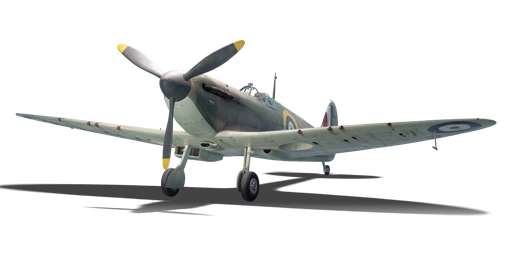



The Supermarine Spitfire was one of the most world's most successful aircraft lines, with over 20,000 built across its 24 marks and numerous sub-variants. One of the most famous British WW2-era aircraft, its distinctive thin, elliptical wings allowed it a greater aerodynamic top speed than most of its contemporaries, while its adaptable airframe allowed the basic design to be continually upgraded into the 1950s. The prototype first flew on 5th March 1936 (four months after the maiden flight of the contemporary Hawker Hurricane), and the plane was quickly ordered into mass production upon demonstration of its capabilities. However, delays in initiating production lines for the aircraft meant that the first production models were only completed by mid-1938. Despite arguably being less important than its Hurricane counterpart, the Spitfire quickly became an icon of the war, particularly with its performance against the Luftwaffe during the Battle of Britain and beyond. While the majority of Spitfires participating in the Battle of Britain were of the Mk I variant, most would be replaced by the Mk II by the end of 1940.
In the game since the start of the Open Beta Test, the Spitfire Mk Ia is equipped with a Rolls-Royce Merlin III engine, producing 1,030 hp; coupled with its light and sleek design, the Spitfire has excellent climb rate and is relatively fast, but its main strength is the extremely tight turn radius. This allows the pilot to confidently draw any opponent into a turning engagement and emerge victorious (bar the occasional biplane and Japanese fighters, against which the superior speed and energy characteristics of the aircraft can be utilised). However, the key drawback of the Spitfire Mk Ia is the mediocre armament. While the 8 Browning machine guns present great volume of fire, they are rather weak and quite limited by convergence due to their spread-out nature across the wings, and thus may require a long time on target to successfully down an opponent.
flaps
flaps
flaps
brake
| Belt | Belt filling | Armor penetration (mm) at a distance: | |||||
|---|---|---|---|---|---|---|---|
| 10 m | 100 m | 500 m | 1000 m | 1500 m | 2000 m | ||
| T/AP/AP-I/Ball/Ball/I | 13 | 12 | 7 | 3 | 2 | 0 | |
| T/AP/AP-I/AP-I/I | 13 | 12 | 7 | 3 | 2 | 0 | |
| IT/AP-I | 13 | 12 | 7 | 3 | 2 | 0 | |
| AP-I/AP-I/I | 13 | 12 | 7 | 3 | 2 | 0 | |












Flight performance | |
|---|---|
Survivability |
|---|
Weaponry |
|---|